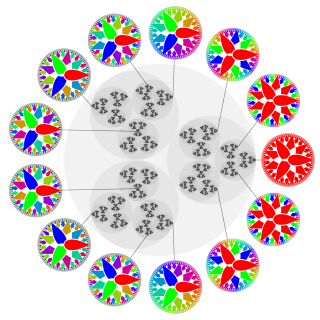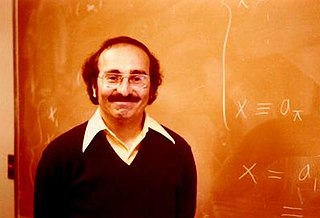
In mathematics, an abelian group, also called a commutative group, is a group in which the result of applying the group operation to two group elements does not depend on the order in which they are written. That is, the group operation is commutative. With addition as an operation, the integers and the real numbers form abelian groups, and the concept of an abelian group may be viewed as a generalization of these examples. Abelian groups are named after early 19th century mathematician Niels Henrik Abel.

An integer is the number zero (0), a positive natural number or a negative integer. The negative numbers are the additive inverses of the corresponding positive numbers. The set of all integers is often denoted by the boldface Z or blackboard bold .
In mathematics, a profinite group is a topological group that is in a certain sense assembled from a system of finite groups.

In number theory, given a prime number p, the p-adic numbers form an extension of the rational numbers which is distinct from the real numbers, though with some similar properties; p-adic numbers can be written in a form similar to decimals, but with digits based on a prime number p rather than ten, and extending to the left rather than to the right.
In number theory, Iwasawa theory is the study of objects of arithmetic interest over infinite towers of number fields. It began as a Galois module theory of ideal class groups, initiated by Kenkichi Iwasawa, as part of the theory of cyclotomic fields. In the early 1970s, Barry Mazur considered generalizations of Iwasawa theory to abelian varieties. More recently, Ralph Greenberg has proposed an Iwasawa theory for motives.
In mathematics, the Hilbert–Smith conjecture is concerned with the transformation groups of manifolds; and in particular with the limitations on topological groups G that can act effectively (faithfully) on a (topological) manifold M. Restricting to groups G which are locally compact and have a continuous, faithful group action on M, the conjecture states that G must be a Lie group.
R. H. Bing was an American mathematician who worked mainly in the areas of geometric topology and continuum theory. His father was named Rupert Henry, but Bing's mother thought that "Rupert Henry" was too British for Texas. She compromised by abbreviating it to R. H. Consequently, R. H. does not stand for a first or middle name.
In mathematics, the Herbrand–Ribet theorem is a result on the class group of certain number fields. It is a strengthening of Ernst Kummer's theorem to the effect that the prime p divides the class number of the cyclotomic field of p-th roots of unity if and only if p divides the numerator of the n-th Bernoulli number Bn for some n, 0 < n < p − 1. The Herbrand–Ribet theorem specifies what, in particular, it means when p divides such an Bn.
In mathematics, equivariant cohomology is a cohomology theory from algebraic topology which applies to topological spaces with a group action. It can be viewed as a common generalization of group cohomology and an ordinary cohomology theory. Specifically, the equivariant cohomology ring of a space with action of a topological group is defined as the ordinary cohomology ring with coefficient ring of the homotopy quotient :
In mathematics, a Witt vector is an infinite sequence of elements of a commutative ring. Ernst Witt showed how to put a ring structure on the set of Witt vectors, in such a way that the ring of Witt vectors over the finite field of order is isomorphic to , the ring of -adic integers. They have a highly non-intuitive structure upon first glance because their additive and multiplicative structure depends on an infinite set of recursive formulas which do not behave like addition and multiplication formulas for standard p-adic integers.
In mathematics, the equivariant algebraic K-theory is an algebraic K-theory associated to the category of equivariant coherent sheaves on an algebraic scheme X with action of a linear algebraic group G, via Quillen's Q-construction; thus, by definition,
In topology, a branch of mathematics, a string group is an infinite-dimensional group introduced by Stolz (1996) as a -connected cover of a spin group. A string manifold is a manifold with a lifting of its frame bundle to a string group bundle. This means that in addition to being able to define holonomy along paths, one can also define holonomies for surfaces going between strings. There is a short exact sequence of topological groups
In commutative algebra, a ring of mixed characteristic is a commutative ring having characteristic zero and having an ideal such that has positive characteristic.
In mathematics, the p-adic gamma function Γp is a function of a p-adic variable analogous to the gamma function. It was first explicitly defined by Morita (1975), though Boyarsky (1980) pointed out that Dwork (1964) implicitly used the same function. Diamond (1977) defined a p-adic analog Gp of log Γ. Overholtzer (1952) had previously given a definition of a different p-adic analogue of the gamma function, but his function does not have satisfactory properties and is not used much.

Ralph Greenberg is an American mathematician who has made contributions to number theory, in particular Iwasawa theory.
Lawrence Clinton Washington is an American mathematician at the University of Maryland who specializes in number theory.
Sallie Ann Keller is a statistician and a former president of the American Statistical Association (2006).
Cynthia Zang Facer Clark is an American statistician known for her work improving the quality of data in the Federal Statistical System of the United States, and especially in the National Agricultural Statistics Service. She has also served as the president of the Caucus for Women in Statistics and the Washington Statistical Society. As of 2018 she is executive director of the Council of Professional Associations on Federal Statistics.
Greenberg's conjecture is either of two conjectures in algebraic number theory proposed by Ralph Greenberg. Both are still unsolved as of 2021.
In mathematics, a Cannon–Thurston map is any of a number of continuous group-equivariant maps between the boundaries of two hyperbolic metric spaces extending a discrete isometric actions of the group on those spaces.



